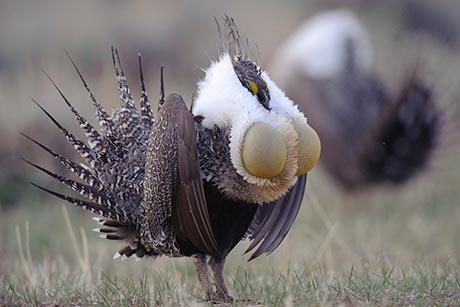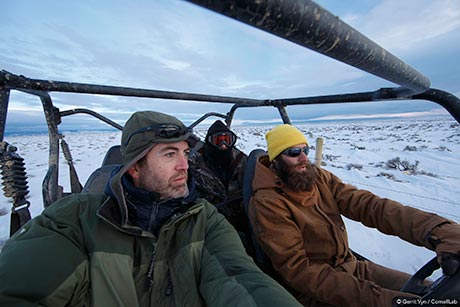Lab of Ornithology wildlife film explores sagebrush species
By Krishna Ramanujan


Conservationists, land managers and policymakers are seeking to protect the greater sage-grouse and its habitat – 165 million acres over 11 western states – while also meeting the needs of ranchers, miners, energy developers and others who rely on high desert sagebrush development for their livelihoods.
With courts poised to decide by the end of 2015 whether to protect the greater sage-grouse and restrict development on sagebrush lands, responsible sides are discussing ways to improve the sustainability of ranching, cluster energy development in areas with low-quality land and restore sagebrush habitat in key areas.
Now, the Cornell Lab of Ornithology has made a 50-minute documentary on the birds and other denizens of the sagebrush land, as well as the tough compromises ahead.
The wildlife documentary, “The Sagebrush Sea” – the first broadcast film produced by the lab – will air on PBS Nature May 20 at 8 p.m. EDT.
“The film is a year in the life of the sagebrush and seen through the eyes of its most emblematic species, the greater sage-grouse,” said Marc Dantzker, a producer in the lab’s multimedia group.
Dantzker, who studied the sage-grouse as part of his doctoral program at University of California, San Diego, produced the documentary.
“Many of the people who live nearby, certainly in the urban centers across the west, don’t know what’s around them in these wide-open spaces,” Dantzker said. “It is such a big country, and you don’t see much [wildlife] unless you get away from people.”
The population of the greater sage-grouse once totaled as many as 16 million but now may be as few as 200,000. They have been studied for their elaborate courtship displays, in which as many as 100 males may congregate to strut and plump plumage and special air sacs in their necks to woo females, said Dantzker. In the end, only a few males get to mate and pass on their genes. The males’ lifespan is only four years, while females live a few years longer.
In addition to the greater sage-grouse, the treeless sagebrush region is home to some 250 species of birds, mammals and other vertebrates. The sage thrasher, sagebrush sparrow and brewer’s sparrow are only found in this habitat, which is also home to pronghorn, mule deer, prairie dogs, golden eagles, sagebrush lizards and pygmy rabbits.
Filming spanned March 2013 to March 2015, and the filmmakers faced challenges of shooting on location in Wyoming, Idaho and Washington.
Filming in the sagebrush’s harsh landscape posed some of the biggest hardships, said Gerrit Vyn, the film’s main cinematographer. “The weather is harsh; it’s really windy, and there is bright sunlight and washed out landscape,” he said.
Sometimes, they camped for a week to find a few days calm enough to shoot film. Also, animals and birds were hard to locate, as many are nocturnal or they live under dense sagebrush cover, Vyn said. The sage-grouse themselves are hidden, blending into the background and sneaking in and out of their bush-covered nests. The filmmakers employed blinds and remote cameras to capture them and other creatures.
Though it was hard to be away from home for long stretches, the scenery and the experience of being in the field through four seasons was spectacular, said Dantzker.
The lab’s multimedia group plans to create educational materials on the sage-grouse for children in the sagebrush region, as well as a version of the film aimed at policymakers, Dantzker said. The group is also producing a separate film on the endangered Philippine eagle.
Lab producer Tom Swartout co-directed the documentary, and filmmaker Allison Argo co-wrote it, with Dantzker.
Private donors to the Cornell Lab of Ornithology’s multimedia group funded the film.
Media Contact
Get Cornell news delivered right to your inbox.
Subscribe